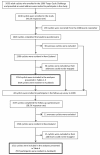The role of multilevel factors in geographic differences in bicycle crash risk: a prospective cohort study
- PMID: 24321134
- PMCID: PMC3893370
- DOI: 10.1186/1476-069X-12-106
The role of multilevel factors in geographic differences in bicycle crash risk: a prospective cohort study
Abstract
Background: Regular cycling plays an important role in increasing physical activity levels but raises safety concerns for many people. While cyclists bear a higher risk of injury than most other types of road users, the risk differs geographically. Auckland, New Zealand's largest urban region, has a higher injury risk than the rest of the country. This paper identified underlying factors at individual, neighbourhood and environmental levels and assessed their relative contribution to this risk differential.
Methods: The Taupo Bicycle Study involved 2590 adult cyclists recruited in 2006 and followed over a median period of 4.6 years through linkage to four national databases. The Auckland participants were compared with others in terms of baseline characteristics, crash outcomes and perceptions about environmental determinants of cycling. Cox regression modelling for repeated events was performed with multivariate adjustments.
Results: Of the 2554 participants whose addresses could be mapped, 919 (36%) resided in Auckland. The Auckland participants were less likely to be Māori but more likely to be socioeconomically advantaged and reside in an urban area. They were less likely to cycle for commuting and off-road but more likely to cycle in the dark and in a bunch, use a road bike and use lights in the dark. They had a higher risk of on-road crashes (hazard ratio: 1.47; 95% CI: 1.22, 1.76), of which 53% (95% CI: 20%, 72%) was explained by baseline differences, particularly related to cycling off-road, in the dark and in a bunch and residing in urban areas. They were more concerned about traffic volume, speed and drivers' behaviour.
Conclusions: The excess crash risk in Auckland was explained by cycling patterns, urban residence and factors associated with the region's car-dominated transport environment.
Figures
References
-
- Litman T. Evaluating Transportation Equity: Guidance for Incorporating Distributional Impacts in Transportation Planning. Victoria Transport Policy Institute: Victoria; 2012.
-
- Higgins P. Exercise-based transportation reduces oil dependence, carbon emissions and obesity. Environ Conserv. 2005;12:197–202. doi: 10.1017/S037689290500247X. - DOI
-
- Mackie H. ‘I Want to Ride my bike’: Overcoming Barriers to Cycling to Intermediate Schools. Wellington: New Zealand Transport Agency Research Report No. 380; 2009.
-
- Winters M, Davidson G, Kao DN, Teschke K. Motivators and deterrents of bicycling: comparing influences on decisions to ride. Transportation. 2011;12:153–168. doi: 10.1007/s11116-010-9284-y. - DOI
Publication types
MeSH terms
LinkOut - more resources
Full Text Sources
Other Literature Sources
Medical
Molecular Biology Databases



